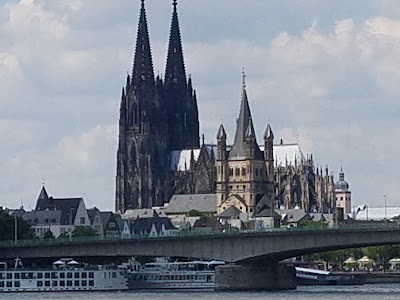Amsterdam is known as "Venice of the North" because of the canals that criss-cross the city, its impressive architecture and more than 1,500 bridges.
We started our day with a canal boat tour through the heart of Amsterdam.
A UNESCO World Heritage Site, the Canal Ring was dug in the 17th century to attract wealthy home owners. It is still a posh neighborhood with many Dutch celebrities owning property.
Ornate lamp posts on this bridge.
Amsterdam's tallest church tower is the Westerkerk, which was completed in 1638. It stands 272 feet tall and its most recognizable feature is the colorful replica of the imperial crown of Maximilian of Austria, who gifted it to Amsterdam in thanks for the city's support.
Our canal ride ended at the Anne Frank House where Anne and her family hid from the Nazi occupation in the city for years before they were finally caught and taken to concentration camps.
Her diary about her time in hiding, published after her death by her father, is one of the world's most widely read books.
Seeing the Anne Frank House was a must-see for us while in Amsterdam. We secured tickets prior to traveling on this trip....in fact 2 months to the day before our visit. I was up early and on the computer the morning that the tickets for this day opened up for sale. They sell out quickly. It is possible to visit the house without prior purchase of tickets, but one must stand in line at 3:00 pm and wait your turn to enter, which could take hours.
I'm glad we didn't have to do that as my cold was getting worse and I wasn't feeling very well at all. We had tickets for a specific time slot and could walk right in.
A little review of Anne Frank's story...
Anne Frank was born in Frankfurt Germany in 1929. She is one of the millions of victims of the Nazi persecution of the Jews during World War II. In 1933, when Hitler comes to power,the Jewish Frank family moved to Amsterdam where Father Otto started a business.
In May, 1940, the German army occupied the Netherlands and anti-Jewish measures are increasingly implemented.
The Frank family goes into hiding in June, 1942 at 263 Prinsengracht in the building where Otto Frank's business is located. The Van Pels family and Fritz Pfeffer join them a while later. The company's building is made up of two parts: a front house and a back house (annex). The eight people in hiding live on the upper floors of the annex.
Anne gets a diary as a present from her parents for her 13th birthday. When the Frank family goes into hiding, Anne's diary goes with her.
Of the eight people in hiding, only Otto Frank survives the war. He makes the decision to have Anne's diary published. In 1960, the hiding place is made into a museum.
We were able to tour the museum and walk up the steep steps behind the book case to the secret hiding place.
Upstairs in the annex, no photographs are allowed; it was an emotional experience to walk through the rooms and imagine what life was like for the families living in hiding.
Anne drew comfort from the ringing of the Westerkerk church bells located across the street from her hiding place.
The statue of her is outside the church.
This young lady was wise beyond her years....
There are more bikes than people in Amsterdam...
The stairwells are so steep and narrow inside the buildings, that in order to move furniture into the apartments, it is put on a rope with a pulley system and hoisted up outside the building and into a window!
After five weeks of travel, we have been in 10 countries, cruised 2,176 miles between the Black Sea and Amsterdam on 3 different rivers and 2 different ships, and enjoyed trip extensions to Transylvania and the Czech Republic.
It was a most wonderful vacation and we are eager to do more river cruises. Our next trip will be in March, 2017 when we go to Asia...see you then!





















































